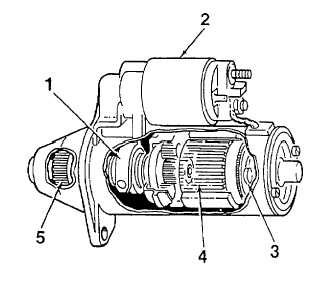TM 9-6115-664-13&P
c.
Engine Oil Cooling. A thermostatically controlled 24 VDC ventilation fan (12) is mounted to the enclosure
behind the nose piece. The fan blows cool air through the engine oil cooler (13), which is mounted directly in front of the
fan. Engine oil circulates from the oil filter housing and through the oil cooler by means of the engine's mechanical oil
pump. The thermostat for the fan is mounted on the oil cooler and activates the fan when oil temperature in the oil cooler
reaches 140º F. The air generated by the fan flows through the oil cooler and exits the enclosure through an outlet baffle,
located next to the engine oil filter access door (11).
1-21. ENGINE STARTING SYSTEM.
a.
Engine start-up is controlled by the engine starter motor (Figure 1-8). When the coil-type starter solenoid (2) is
energized, magnetic force pulls the solenoid plunger in. The plunger is connected to a spring loaded engagement fork
(1). This engagement fork pushes the drive pinion (5) out to engage the engine flywheel.
b.
As the drive pinion (5) is pushed out, the armature (4) contacts the starter motor brushes (3), energizing the
starter's field winding. The starter motor will operate until the solenoid (2) is de-energized. Once deenergized, the
engagement fork (1) will retract and the drive pinion will disengage from the engine flywheel.
1. Engagement Fork
2. Starter Solenoid
3. Motor Brushes
4. Armature
5. Drive Pinion
Figure 1-8. Engine Starter Motor
1-22. ENGINE COMBUSTION CYCLE.
a.
The diesel engine combustion cycle can be divided into four separate strokes; compression stroke, power
stroke, exhaust stroke, and intake stroke. Thus the term four-stroke engine is applied to this type of unit.
b.
Compression Stroke. During the compression stroke, the engine starter motor cranks the engine flywheel (1,
Figure 1-9). The crankshaft (2) turns, forcing the piston (3) to rise to its highest point in the cylinder (4). The upward
movement of the piston compresses air trapped inside the combustion chamber, causing temperature to rise over 932
degrees F. A fine mist of fuel is sprayed into the combustion chamber by the fuel injector (5) just before the piston
reaches its high point. The compressed air and fuel mixture combusts.
1-20

